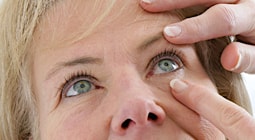Chemicals in the Eye
If you get an acidic or caustic chemical in your eye (e.g., chemical burn), please stop reading this and rinse your eyes with cool, clean tap water. Do this for 15 minutes, and then call us or go directly to the nearest emergency room.
Mechanical Injury to the Eye
If you mechanically injure your eye, or if something gets in your eye, do not apply pressure.
Cover your eye with a rigid shield, but do not put anything under the shield that would press on your eye. A rigid shield can be fashioned from the bottom of a paper cup. Alternatively, put your glasses or sunglasses on, which will also provide protection.
Minor Eye Injury
For less urgent injuries, call our office to schedule to see a doctor.
Flashing Lights & Floaters
The sudden onset of many floating spots and flashing lights along with a black curtain or shade that seems to cover part of your vision may represent a retinal tear or detachment. An examination is essential as soon as these symptoms appear.
Anyone who has the onset of new floaters with or without flashing lights should be seen for a dilated fundus exam as soon as possible.
Viral Conjunctivitis
Viral conjunctivitis is a very common infection of the outer layer of the eye called the conjunctiva. Treatment is largely supportive, consisting of cool compresses and artificial tears. Often we give an antibiotic ointment to soothe the eye and protect it from bacterial infection, but this does not treat the viral process (which resolves on its own).
Patients with viral conjunctivitis are contagious for approximately seven days after the onset of symptoms. Patients should be very careful to avoid touching their eyes—frequent hand washing is advised. The symptoms of viral conjunctivitis can last up to three weeks and may fluctuate before finally resolving.
Viral conjunctivitis is common, especially in the winter months. Nonetheless, not all cases of red eye are viral conjunctivitis, and anyone who has a red eye that does not seem to be improving should see an optometrist to rule out other causes.
















